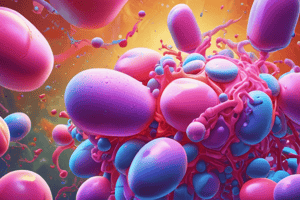Podcast
Questions and Answers
Qual é a principal diferença entre a administração intramuscular e a administração intravenosa de medicamentos?
Qual é a principal diferença entre a administração intramuscular e a administração intravenosa de medicamentos?
- A administração intramuscular tem um início de ação mais rápido do que a administração intravenosa.
- A administração intramuscular causa menos dor do que a administração intravenosa.
- A administração intramuscular permite a entrega de volumes maiores em comparação com a administração intravenosa. (correct)
- A administração intramuscular requer um treinamento específico, enquanto a administração intravenosa não exige treinamento.
Quais são os principais fatores que influenciam a taxa de absorção de um medicamento?
Quais são os principais fatores que influenciam a taxa de absorção de um medicamento?
- A cor do medicamento e o sabor do medicamento.
- O preço do medicamento e a embalagem do medicamento.
- A solubilidade do medicamento, o tamanho molecular e a presença de transportadores. (correct)
- A marca do medicamento e o país de fabricação do medicamento.
Quais são os principais efeitos colaterais associados à administração nasal de medicamentos?
Quais são os principais efeitos colaterais associados à administração nasal de medicamentos?
- Irritação nasal e congestão nasal. (correct)
- Sonolência e perda de apetite.
- Dor de cabeça e tremores.
- Constipação intestinal e náuseas.
Como os medicamentos altamente ligados às proteínas tendem a se distribuir no corpo?
Como os medicamentos altamente ligados às proteínas tendem a se distribuir no corpo?
Qual é o principal benefício da administração retal de medicamentos em relação ao metabolismo de primeira passagem hepática?
Qual é o principal benefício da administração retal de medicamentos em relação ao metabolismo de primeira passagem hepática?
Quais são os mecanismos primários envolvidos na absorção de medicamentos?
Quais são os mecanismos primários envolvidos na absorção de medicamentos?
Qual é a principal vantagem da administração oral de medicamentos em comparação com outras vias de administração?
Qual é a principal vantagem da administração oral de medicamentos em comparação com outras vias de administração?
Quais são as desvantagens da administração intravenosa de medicamentos?
Quais são as desvantagens da administração intravenosa de medicamentos?
Qual é a principal característica da administração subcutânea de medicamentos?
Qual é a principal característica da administração subcutânea de medicamentos?
Quais são os potenciais efeitos colaterais associados à administração intramuscular de medicamentos?
Quais são os potenciais efeitos colaterais associados à administração intramuscular de medicamentos?
Como a administração intranasal de medicamentos difere da administração oral em termos de velocidade de absorção?
Como a administração intranasal de medicamentos difere da administração oral em termos de velocidade de absorção?
Como a absorção dos medicamentos via retal difere da absorção oral?
Como a absorção dos medicamentos via retal difere da absorção oral?
Study Notes
Understanding Drug Administration and Metabolism: Routes, Absorption, Distribution, and Clearance
In the field of medicine, understanding drug administration and metabolism plays a crucial role in ensuring safe and effective treatments. By examining the routes of drug administration, absorption, distribution, and clearance, we gain insights into how medicines interact with the body and how they are processed for elimination.
Routes of Drug Administration
There are several primary routes of drug administration: oral, intravenous (IV), subcutaneous (SC), intramuscular (IM), topical, rectal, and intranasal. Each route offers advantages and disadvantages, such as ease of administration, rapid onset of action, duration of effect, and potential for side effects:
- Oral: Liquids, capsules, tablets, or sprays ingested by mouth. This route allows for self-administered medications and is often the preferred choice for daily therapies due to convenience. However, it may take longer to achieve peak concentration compared to other routes.
- Intravenous: Direct injection into a vein. IV delivery provides immediate access to the circulation, allowing for quick onset of action and potentially short durations of effect. However, invasiveness and potential complications limit its use.
- Subcutaneous: Injection under the skin. SC administration allows for controlled release, offering extended periods of effect without frequent dosing demands. However, the injection site may become uncomfortable if administered frequently.
- Intramuscular: Depth injection into a muscle. IM administration typically delivers larger volumes compared to IV injections, providing extended durations of action. However, the procedure requires training and can result in painful injections.
- Topical: Applied to the surface of the skin, mucous membranes, gastrointestinal tract, or eyes. Topical drugs offer targeted local effects, minimizing systemic side effects, but may require constant contact or multiple applications.
- Rectal: Inserted into the rectum or applied to the anal area. Rectal administration allows direct entry into the bloodstream, bypassing hepatic first-pass metabolism. However, the method may be less convenient and may produce inconsistent absorption rates.
- Intranasal: Nasal spray or drops placed directly into the nostrils. This route avoids first-pass metabolism and provides faster onset of action compared to oral administration. However, it may cause irritation or nasal congestion, limiting patient compliance.
Drug Absorption
Once a drug is administered, it moves through the body's biological barriers, such as the gastrointestinal tract, blood-brain barrier, or blood-testis barrier, to reach its target site. The rate of absorption depends on factors like the drug's solubility, molecular size, and the presence of transporters. For example, passive diffusion and active transport are two primary mechanisms of absorption:
- Passive diffusion: Small, lipid-soluble molecules passively diffuse across cellular membranes from areas of high concentration to areas of low concentration.
- Active transport: ATP-dependent processes actively transport drugs across cellular membranes against concentration gradients.
Drug Distribution
After absorption, drugs distribute throughout the body according to their physicochemical properties, such as protein binding, lipid solubility, and molecular size. Drug distribution patterns can be influenced by the pharmacokinetics of the drug, including tissue-specific enzymes and transporters that may metabolize or excrete the drug. For example, highly protein-bound drugs tend to accumulate in tissues with high protein concentrations, such as the liver, spleen, and kidneys:
- Tissue binding: Drugs bind to proteins and cellular components in various tissues, including plasma proteins, erythrocytes, and liver tissues.
- Lipid partitioning: Lipid-soluble drugs can cross cellular membranes, allowing them to penetrate deeper into tissues and organs.
- Effect of plasma proteins: Protein binding can affect drug distribution by reducing the amount of free drug available for transport and metabolism.
Drug Clearance via the Kidneys
The kidneys play a significant role in drug clearance, primarily through the excretion of unchanged drugs or their metabolites into the urine. The kidneys' ability to excrete drugs depends on factors like the drug's water solubility, protein binding, and the acidity of urine:
- Glomerular filtration: Drugs pass through the glomeruli, the filtration units of the kidney, into the renal tubules for further processing.
- Renal tubular secretion: Certain drugs are actively transported into the renal tubules for excretion.
- Renal tubular reabsorption: Some drugs may be reabsorbed into the bloodstream before being excreted, reducing their overall clearance.
- Renal drug transport: Transporters in the renal tubules can influence the clearance of drugs by either promoting their excretion or preventing their reabsorption.
In summary, understanding drug administration, absorption, distribution, and clearance is essential for developing safe and effective drug therapies. By examining these processes, healthcare professionals can make informed decisions about drug dosing, administration routes, and potential interactions, ultimately improving patient outcomes.
Studying That Suits You
Use AI to generate personalized quizzes and flashcards to suit your learning preferences.
Description
Este quiz aborda a administração de medicamentos por várias vias, absorção no corpo, distribuição nos tecidos e processos de eliminação. Ao compreender esses aspectos, é possível melhorar a segurança e eficácia dos tratamentos médicos.



